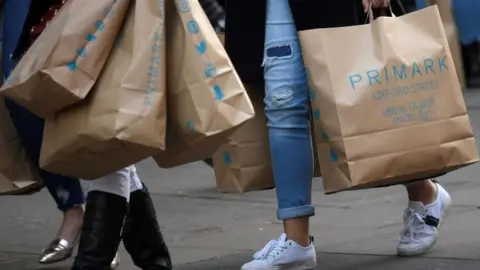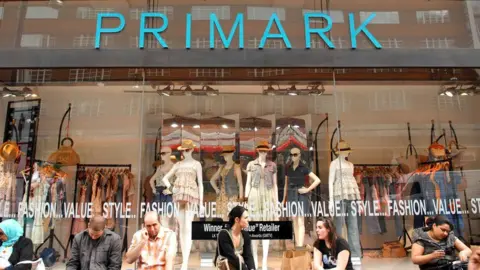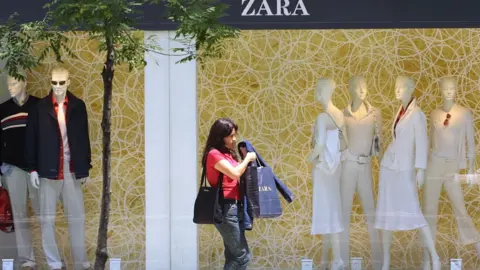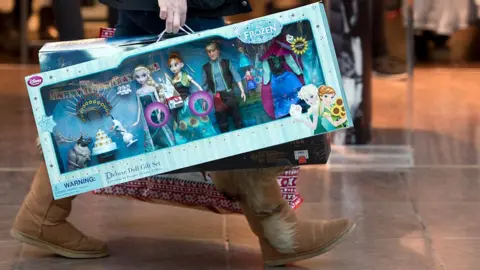Six shops defying the High Street downturn
 Reuters
ReutersSometimes it seems there's nothing but doom and gloom on the UK's High Streets.
This week we heard profits were down at Debenhams and a big deal between shopping centre owners Hammerson, which owns Birmingham's Bullring, and Intu fell through.
New store openings are at their lowest level for seven years. And mid-range restaurants are closing branches left, right and centre.
But that doesn't mean things are going awry for everyone. There are still some retailing bright spots.
JD Sports
"The middle- or mass-market is very difficult in the High Street and you have to look to the premium end and the discount end of the market for the good stories," says independent retail analyst Nick Bubb.
He puts JD Sports in the former category, along with brands such as John Lewis, Joules, Hotel Chocolat and Superdry.
The purveyor of "athleisure" - fashionable sports clothes and shoes - displays prestigious brands prominently, and uses in-store technology to provide a upmarket feel.
George Salmon, equity analyst at Hargreaves Lansdown says: "That's what the customer wants - the latest offering from Nike and Adidas. We've seen that in the numbers."
 JD Sports
JD SportsPositioned one notch higher in the market than Sports Direct, it has also benefited from its rival's difficulties.
Results this week showed sales up 33% for last year with profits 24% higher, and the company said it's looking at expanding into the US market.
Primark
At the other end of the market, fashion chain Primark is leaving rivals like New Look for dust by sticking to one principle.
"Price is the main thing," says Mr Salmon. "Price is always front and centre."
Sometimes you hear that to survive retailers must have a strong online offering, or should provide in-store theatre to keep customers coming back. Primark does neither.
Instead it's the Lidl of clothing retail: pile 'em high, sell 'em cheap. And it works. This week Primark reported higher UK sales and plans for two new stores.
 Press Association
Press AssociationBut Kate Hardcastle, retail analyst at Insight With Passion, says there's more to it than that.
"If you look at their Instagram they have a following of 5.3 million.
"They're connecting the public with what's in store and creating a conversation.
"There's no big ad campaign, no supermodels. They're just getting customers into the store."
Zara
It is Zara's business model that keeps it ahead of the pack, says George Salmon.
The Spanish-owned company is "vertically integrated", in other words it manufactures a lot of the clothes it sells, rather than outsourcing via complicated supply chains in far flung parts of the world.
 MARC ALEX
MARC ALEXMs Hardcastle says that offers them a degree of agility that is hard for other High Street stores to match.
"It's not just because they offer fashion at a reasonable price, it's the speed at which they bring it into store.
"Traditionally it used to be that shops had spring, summer, autumn, winter ranges and rarely updated them.
"Zara does it every week, at the same speed as Asos does online. That's operational excellence."
Disney
If you went into a Disney store a decade ago, you'd have seen what they called the "pile of plush" - a huge pool of soft toys.
But Disney realised that whilst retailers think in categories such as lunchboxes, dressing-up clothes and dolls, children don't.
"Children buy by film or character," says Kate Hardcastle. "If they like Buzz Lightyear, they want things to do with Buzz Lightyear. It's simple but incredibly important.
 Getty Images
Getty Images"Disney put toys at child height, they engage with children, and no one has to buy anything," she says.
They also let children pull things off the shelves to look at, and staff patiently put them back afterwards with an indulgent smile, because that's the experience children want in a toy shop.
"It's all about connecting with the brand," says Ms Hardcastle.
Lego has cottoned on in much the same way.
Lush
"What Lush offers is a product that is unique. They're not selling L'Oreal or Max Factor. They're not selling fast moving consumer goods. They sit on their own," says Richard Lim, chief executive of Retail Economics.
The highly fragrant, highly principled cosmetics chain has a very clearly defined clientele and offering. Along with bathbombs and bubbles it offers politics and principles.
Their products are made in the UK, animal and environment friendly, and are accompanied with campaigning messages on subjects from gay rights to global trade.
 Lush
Lush"The core values of the company resonate with their consumers," says Mr Lim. "They are authentic by staying true to those core values and offering a product not available elsewhere. That is the magic sauce."
A lot of retailers talk about WACD, or "what Amazon can't do". Lush is WACD.
Domino's
Casual dining has been particularly hard hit in recent months. But Domino's said over Christmas they were gaining customers as people were opting to spend Saturday night in front of the TV.
The pizza delivery firm is not the only one benefitting from the eating-in trend. The likes of Deliveroo and Just Eat are also doing well, which in turn supports independent High Street restaurants like your local curry house.
 Domino's Pizza
Domino's PizzaBut Domino's has done a particularly good job of gaining a foothold in consumers' minds, says George Salmon.
"Their advertising and branding is very strong," he says. "You hear people say: shall we get a Dominos? It's in the parlance."
But, warns Mr Salmon, there is a risk of cannibalisation.
"The worry is, what happens if we get to the point where we're saturated with Domino's?
"Do we need one at each end of the High Street? Probably not."
